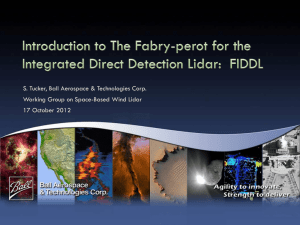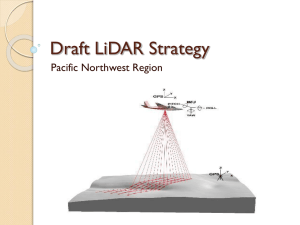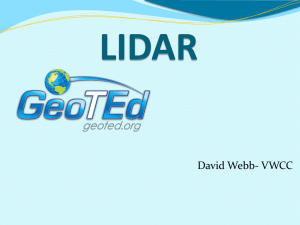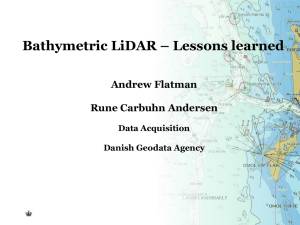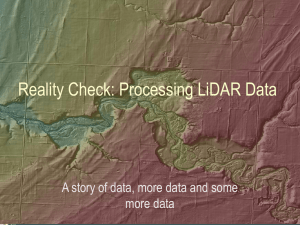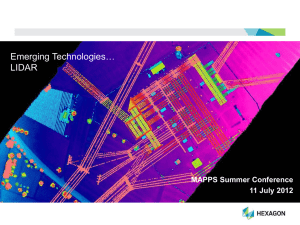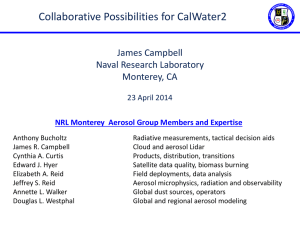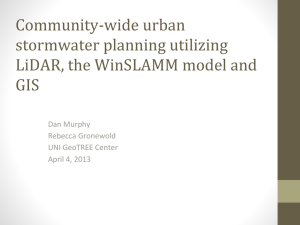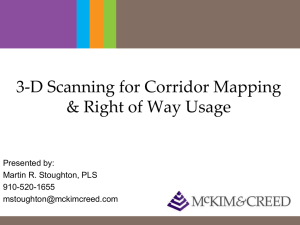FIDDL The Fabry-perot etalon for the Integrated Direct Detection Lidar
advertisement
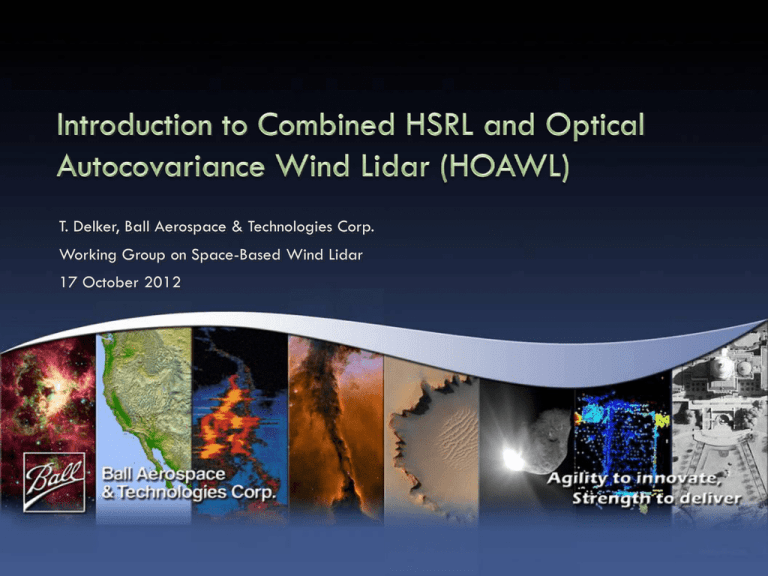
T. Delker, Ball Aerospace & Technologies Corp. Working Group on Space-Based Wind Lidar 17 October 2012 HOAWL relevance to Working Group Openings meeting goals by Mike Hardesty Action Item List “Can we combine a wind mission with another decadal survey mission to move up the priority list?” “5. Continue to explore design modifications to a DWL mission for additional earth science measurement capabilities” HOAWL combines Winds and HSRL in same instrument Opportunity: Combine lidar portion of ACE mission with 3D-Winds mission Working Group on Space-Based Wind Lidar, 16-18 October 2012 - Boulder, CO pg 2 HOAWL Executive Summary HOAWL funded under NASA’s ESTO 2011 ACT Program Will result in measurements of both HSRL and wind in one instrument Reuses much of OAWL Hardware Upgrades hardware to allow two wavelength measurements Develop and measure HOAWL calibration factors for HSRL products Develop algorithms No impact on winds measurement Wind measurement achieved through measuring phase of fitted sine HSRL backscatter achieved by measuring amplitude and offset of fitted sine Much of initial engineering and hardware already in place from IIP Calibration need to turn amplitude and offset in to HSRL Any improvements to the instrument that increase SNR of HSRL will also increase wind measurement SNR Allows off-nadir HSRL measurements Doppler-shift does not effect HOAWL-HSRL retrievals Working Group on Space-Based Wind Lidar, 16-18 October 2012 - Boulder, CO pg 3 The HOAWL team Electrical……………………… Mike Adkins Optical……………………….. Shaun Ashby Harlan Kortmeyer PI, PM, Optical……………….. Tom Delker Software……………………… Dave Gleeson CO-I …………………………. Christian Grund Mechanical…………………… Miro Ostaszewski CO-I/Modeling/Algorithms…... Sara Tucker Management Support…………Carl Weimer Ray Demara Working Group on Space-Based Wind Lidar, 16-18 October 2012 - Boulder, CO pg 4 HOAWL Introduction ACT will add HSRL retrievals to OAWL Delivers both winds from aerosols and atmospheric composition measurements OAWL works as a system Successfully showed wind retrievals from ground with collocated coherent doppler wind lidar1 Successfully showed wind retrievals and Doppler-shifted ground returns from air platform (WB-57)2 HSRL hardware upgrades Current OAWL only working for 355 nm Add 2nd wavelength channel (532 nm) New collimator New waveplates Add signal acquisition card to data system Rework detectors New Depolarization channel Optical system realignment System characterization 1) Tucker et al, (2012): Wind Profiling with the Optical Autocovariance Wind Lidar: Results of Validation Testing, AMS 92nd Annual Meeting, 22-26 January, 2012 – New Orleans, LA 2) Tucker et al, (2012): Successes of the OAWL IIP and next steps (with a FIDDL), Working Group on Space-based Wind Lidar, 1-2 May 2012 - Miami, FL Working Group on Space-Based Wind Lidar, 16-18 October 2012 - Boulder, CO pg 5 Why HSRL Goal Measure atmospheric aerosol scattering and extinction profiles High Spectral Resolution Lidar Lidar = range resolved measurements Supports ACE, GACM and GEO-CAPE missions Something passive instruments can’t do and need High spectral resolution => Can see effect of line broadening of laser light caused by molecular backscatter Allows separating aerosol from molecular backscatter Single wavelength insufficient to provide needed information for aerosol characterization HRSL retrievals Backscatter (β) Three wavelengths preferred OAWL currently configured for 2 wavelengths, could support three (355nm, 532, 1064 nm) Extinction (α – for attenuation) Two wavelengths (355 nm, 532 nm) Depolarization (δ) Two wavelengths (355 nm, 532 nm) Working Group on Space-Based Wind Lidar, 16-18 October 2012 - Boulder, CO pg 6 Aerosol vs. Molecular Coherence As a result…. Aerosol return has approximately the same narrow bandwidth & temporal coherence length as the outgoing laser pulse. Molecular return has a wide bandwidth due to all the Doppler shifts from the molecular vibrations (Doppler broadening) shorter temporal coherence length. The center of both returns is Doppler shifted by the line-of-sight wind speed V, according to: 2.5 c Where fo is the outgoing laser pulse frequency = c/λ0 c is the speed of light f0 Doppler Shift Due to wind 2 Backscatter (W) f Doppler 2 V 1.5 1 Return spectrum from a Monochromatic source A+M+BG A 0.5 0 M BG 160 80 40 20 10 0 10 20 40 80 160 Wavelength Shift (m/s) Working Group on Space-Based Wind Lidar, 16-18 October 2012 - Boulder, CO pg 7 Separate Molecular vs. Aerosol Aerosol return (narrower BW) exhibits good fringe contrast over a range of OPDs Molecular return (broader BW) fringe visibility is negligible (~1012) at HOAWL’s 0.9 meter OPD The atmospheric return is the combination of the two. The HSRL retrieval is in the separation of these two plus noise. Fringe contrast or interferometer visibility (V = (Imax-Imin)/(Imax+Imin)) depends on: Maximum system contrast, Vmax Optical Path Difference, OPD Temporal Coherence length of the laser backscatter from atmosphere, Lc Working Group on Space-Based Wind Lidar, 16-18 October 2012 - Boulder, CO V ( OPD ) V max e OPD / L c pg 8 Phase(wind), Amplitude (Aerosol), and Offset (Molecular) Four channels: Ideally, these are aligned to detect the 0, 90, 180, and 270 phases of the interferometric signal. [0, 90, 180, 270] could be [135, 225, 315, 45] or any set of values separated by 90. The T0 detector phase definitions are arbitary – but used to define the current state of the interferometer. For each time stamp, perform a sinusoidal fit to the detector amplitudes at these phases phase, amplitude, and constant (‘dc”) offset of the fit are returned. Phase provides the wind Amplitude provides polarization-preserved Aerosol content Aerosols return has ~same contrast as outgoing laser pulse Calibrated with To signal shot to shot (ideally) Offset provides polarization-preserved molecular content Widened spectrum of molecular backscatter is incoherent for chosen optical path different Results in offset in sine fit D V I max I min I max I min D DO Working Group on Space-Based Wind Lidar, 16-18 October 2012 - Boulder, CO D O pg 9 HSRL Data Products Measurement or Description (all a function of range) retrieval Pm =Pm ǁ Return from molecular backscatter in the co-polarized OAWL receiver Pa =Pa ǁ Return from aerosol backscatter in the copolarized OAWL receiver δa αa+m αa ta βa Ra Ram Aerosol depolarization ratio: Pa/Paǁ Total extinction Aerosol extinction coefficient Aerosol optical depth Aerosol backscatter Aerosol lidar ratio: αa /βa Aerosol to molecular backscatter ratio: βa/βm Working Group on Space-Based Wind Lidar, 16-18 October 2012 - Boulder, CO D C aD Pa C mD Pm O C aO Pm C mO Pm C mD V m C mO 1 V m C aD V a C aO 1 V a pg 10 HSRL from Previous OAWL Data Previous OAWL data used to test algorithm development Ground validation data Single Channel (355 nm) Caveats Overlap affects extinction estimate at the near ranges (common problem for all HSRL systems). Horizontal view at low altitude lots of extinction SNR drops at farther ranges. “ringing” in noise floor (believed to be from Q-switch electronics) falsely affects extinction estimate. To was not optimized (equal To and telescope path contrast not ensured). Don’t have actual depolarization measurements aerosol backscatter may be too high/low No calibration has been performed. Don’t have actual depolarization measurements aerosol backscatter may be too high/low Very difficult to validate with Denver data. Working Group on Space-Based Wind Lidar, 16-18 October 2012 - Boulder, CO pg 11 Successes Output values are “reasonable” (i.e. within normal ranges) where SNR is strong and overlap issues are lessened. Average of output (i.e. for aerosol backscatter, or aerosol extinction/AOD) is not affected by number of points used in the average (other than more points leads to smaller variance). Data “generally” follow Denver air quality data (too many variables for good comparison) Working Group on Space-Based Wind Lidar, 16-18 October 2012 - Boulder, CO pg 12 Preliminary Results: 11 July 2011 150 m range gates, 4 second averages Working Group on Space-Based Wind Lidar, 16-18 October 2012 - Boulder, CO pg 13 Preliminary Results: 13 July 2011 37.5 m range gates, 1 sec. averaging High aerosol backscatter & extinction day Working Group on Space-Based Wind Lidar, 16-18 October 2012 - Boulder, CO pg 14 Preliminary Results: 21 July 2011 150 m range gates, 4 sec. averaging Medium to low aerosol backscatter & extinction – overlap effects are also present Note different color scales Working Group on Space-Based Wind Lidar, 16-18 October 2012 - Boulder, CO pg 15 Average output results Averages for full data set (2+ hrs) 150 m range gate on inputs Not verified, but all within reasonable limits. Biases (intensity & extinction) likely present due to rangedependent offsets (from Q-switch noise) and … …from possible changes in system setup (experiment was intended for winds, not HSRL – some mods were made) Working Group on Space-Based Wind Lidar, 16-18 October 2012 - Boulder, CO 11 July 2011 13 July 2011 14 July 2011 19 July 2011 21 July 2011 pg 16 HOAWL ACT Summary HOAWL ACT will demonstrate: Two wavelength HSRL measurement Two wavelength Aerosol wind measurement Hardware upgrades underway Initial hardware upgrades happening now Rooftop demonstration by end of this year Additional hardware upgrades following first dual wavelength retrievals Final data sets and wrap up ACT in early 2014 For FIDDL hardware integration Algorithms under development Some preliminary HSRL results from existing wind data Working Group on Space-Based Wind Lidar, 16-18 October 2012 - Boulder, CO pg 17 HOAWL for LIDAR potion of ACE mission HOAWL can deliver data for lidar portion of ACE baseline concept Backscatter at 355 nm, 532 nm, 1064 nm Extinction at 355 nm and 532 nm Depolarization at 355 nm and 532 nm In addition - Aerosol wind at 355 nm and 532 nm HSRL 3β + 2α + 2δ Add FIDDL for molecular if desired and fits in cost Minor hardware changes add HSRL to OAWL Photons already there Emit existing 1064 nm and 532 nm light generated by laser Multiwavelength optical components Add backscatter channel at 1064 nm Dichroic with detector Add depolarization channel 355 nm and 532 nm Add 4 detectors at output interferometer Byproduct of 355 nm light currently used by OAWL Already exist in current OAWL It’s not free, but it’s not expensive Could descope some parts 1β + 1α + 1δ comes at the cost of just a single extra detector Working Group on Space-Based Wind Lidar, 16-18 October 2012 - Boulder, CO pg 18 3D Winds plus LIDAR potion of ACE mission Makes mission more relevant to NASA Decadal survey already ranks 3-D winds mission low Especially when/if ADM-Aeolus flies BUT, make sure cost increase is minor Maximize science/cost ratio CLARREO lesson – Don’t try to do too much GEO-CAPE is taking the clue Separating Ocean Color from Aerosol Mission Is this an ACE Mission with 3-D winds for free? Use ACE for higher decadal survey position Get winds from lidar portion of ACE via HOAWL for free It’s too expensive It costs to add HSRL to 3-D winds Need to verify Do ACE mission and 3-D winds mission orbits overlap? Do viewing and pointing requirements overlap? Does HOAWL meet ACE HSRL measurement accuracy and precision? Need to engage ACE mission scientists Goal: One system, one laser, global winds & aerosols. Working Group on Space-Based Wind Lidar, 16-18 October 2012 - Boulder, CO pg 19
